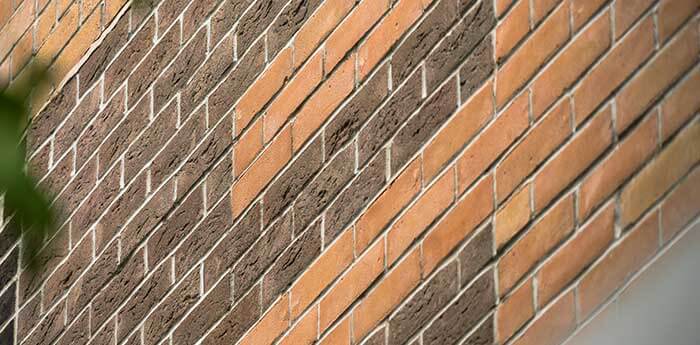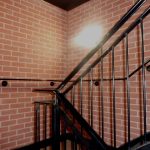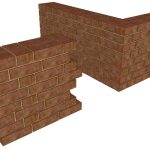Types of Bonds
The bricks being uniform in size can be arranged in a variety of ways. The following are the various types of bonds used in brick masonry :
Stretcher Bond.

Stretcher bond
In this type of Bond all the bricks are laid as stretchers, that is length wise, as shown in Fig. 2.29. This bond is used-in half brick thick walls.
Header Bond

Header bond
In this bond, all the bricks are laid all headers. The elevation of the wall laid in header bond is shown in Fig. 2.30. This bond is used for curved surfaces in work such as well lining or well foundation etc.
English bond
This is the most common and popular bond and is used in most of the structures. The English bond consists of alternate layers of headers and stretchers. That is to say, one layer will be of stretchers and the other layer of headers.
The following are main features of English bond :

Isometric view of English bond
· The alternate courses are of headers and stretchers.
· Each alternate header is centrally supported over a stretcher.
· If the thickness of a wall is an uneven or odd number of half bricks, there will be best stretchers on the face and headers on the back, similarly headers on the face and stretchers on the back of the wall in every course.
· If the thickness of the wall is an even number of half bricks, there will be stretchers on the face and stretchers on the back ; similarly, headers on the face and headers on the back every course of the wall.
· The walls having a thickness of two bricks or more will have stretchers or headers on the face and back of the wall whereas the interior will be filled with header only.
Arrangement of Bricks in English Bond
Two, one brick thick walls meeting at right angles at the corner. Fig. 2.32.

One brick walls meeting at corner
Two one and a half brick walls meeting at right the corner. Fig. 2.33

One and half brick walls
Two, two bricks thick walls meeting at right angles at the corner. Fig. 2.34

Two brick walls
Two walls, one brick thick and one and a half brick thick, meeting at right angles at the centre (T-junction). Fig. 2.37.

One and half brick in T junctions
Two brick and one and a half brick T-junction, (e) Two, one and a half brick thick walls crossing each other at right angles. Fig. 2.39.

Wall crossing in English bond
Flemish Bond.
Isometric view of double flemish bond

One brick thick flemish bond corner

One and half brick corner in flemish bond

Two brick corner in Flemish bond

T-junction in Flemish bond

T junctions in flemish bond

In this type of bond, each course consists of header and structures alternately arranged. The Flemish bond as of two types, viz, Single Flemish and Double Flemish, The single Flemish bond consists of Flemish bond on the face of the wall and English bond on the back of the wall. Whereas the double Flemish bond consists of Flemish bond on the face as well as on the back of the wall.
Flemish bond admits the use of greater number of brick bats and hence it is economical. But English bond is stronger than Flemish bond. It is also claimed that Flemish bond is better in appearance than the English bond.
Dutch Bond.
It is a modification over the English bond and consists of alternate courses of headers and stretchers, except that every stretcher course starts with a three-quarter brick and in every alternate stretcher course in header is placed after the three quarter brick as shown in Fig. 2.46.

Dutch bond
Raking Bond.
The walls which are more than two-brick thick will become weaker in longitudinal strength, as the headers being used in the interior of the wall to increase the transverse strength. This defect is removed by using raking bond (rake means inclination). In this bond the bricks are laid at some inclination to the face of the wall.

Raking bond – Herring bone bond, Diagonal bond
There are two varieties of raking bond, Diagonal bond and Herring bone bond.
(i) Diagonal bond.
This type of bond is employed in walls, which are 2 to 4 thick. In this bond, the face bricks are first laid and then the bricks are laid diagonally. The inclination of the bricks should be so adjusted that the bricks may be filled without cut ting.
(ii) Herring bone bond.
This bond is best suited for walls which are at least 4 bricks thick. In this case, the bricks are laid at an angle of 45° in both directions, commencing from the center line as shown in Fig. 2.47.
Raking bond pattern of laying bricks is also sometimes used for laying bricks on the floors.
Garden Wall Bond.

English garden bond

Flemish garden bond
There are two types of garden wall bond viz. English Garden Bond and Flemish Garden Bond. In the English garden bond, one course of headers is used after every three to four courses of stretchers, whereas in the Flemish garden bond, in each course one header is used after every three or four stretchers
Facing Bond.
This bond is used when the bricks for the face work are costlier than the other bricks and as such the number of face bricks is economized by using more stretchers. This bond is also used when the thickness of the face and back bricks is different. There are a number of stretcher courses followed by header courses. The thickness of stretcher courses should be multiple of the thickness of thinner bricks. For example, the thickness of face bricks is 5 cm and that of back bricks in 3 cm. Then after three courses of face bricks and five courses of back bricks the height of face and back bricks will become the same. Now at this height header course should be provided.


